A How-To Guide for Ordering Synthetic Web Slings
Did a recent inspection of your rigging gear reveal your synthetic web slings are no longer in compliance with the standards set forth by ASME B30.9 Slings?
When it comes time to replace those slings, there may be some confusion with how to order the right replacement slings so you and your company can continue executing safe and efficient lifts with minimal downtime.
Mazzella has been in the rigging business since 1954, and has the experience to help clear up the confusion. This article is one in a series of content designed to show you how to order the correct slings for your lifting applications.
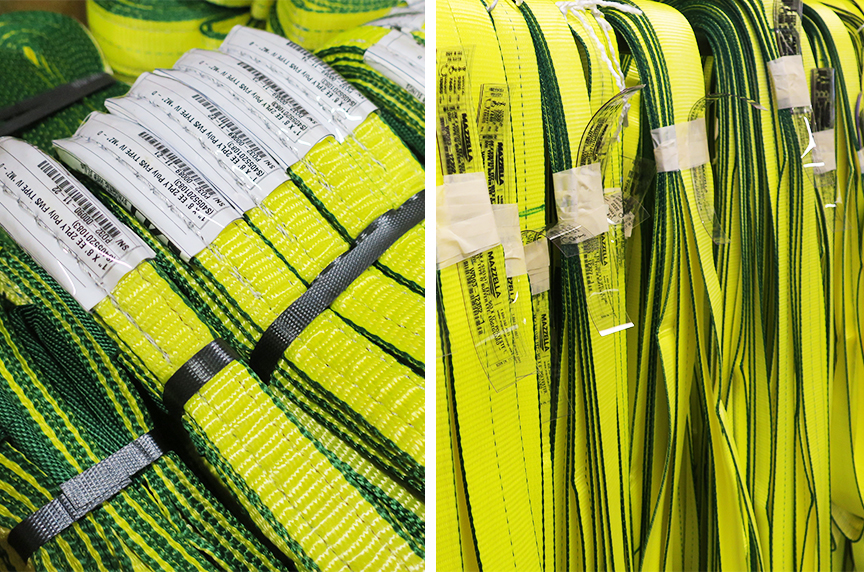
In this article, you’ll learn the answers to the following questions:
- What do you need to know before ordering web slings?
- What questions do you need to answer before ordering a web sling?
- What questions should you ask before ordering a web sling?
- What are good-fit environments for a web sling?
- How many plies are needed to execute safe lifts?
- What are the different types of web sling configurations?
- What types of eyes can web slings have?
- Why would you choose one type of eye over another?
- How do you measure web sling length?
- What protection is recommended for web slings?
What Are the Different Types of Web Sling Configurations?
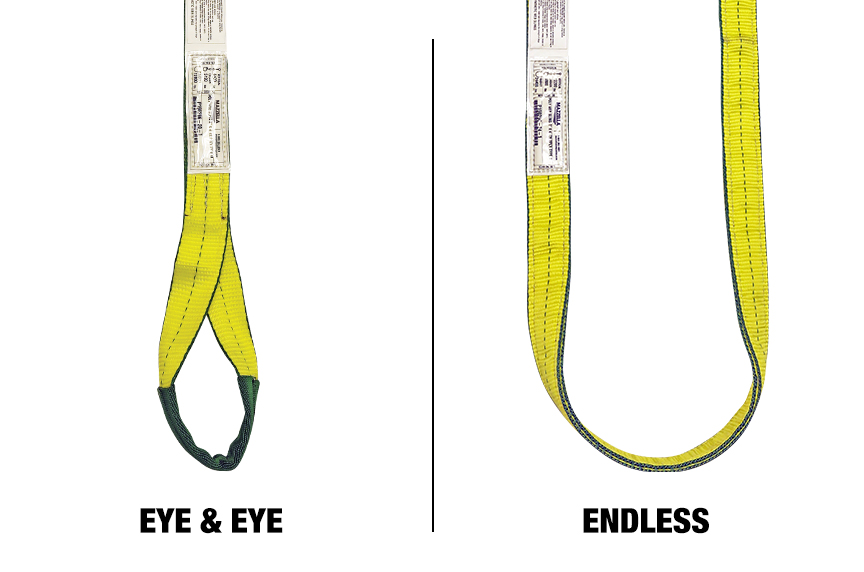
Web slings are pretty similar in configuration to other sling types, like wire rope slings.
Web slings come in several different configurations, including:
- Single or multi-leg bridle assemblies
- Eyes formed on both ends of the sling
- An endless or infinite loop configuration (similar to a synthetic roundsling)
- With fittings on both ends of the sling
Hardware manufacturers make special hooks for web slings, and instead of your traditional eye on a hook, they actually make a flat surface on the hook. This way, the web sling will sit properly against the hook without getting cinched up, which allows you to get the maximum lifting strength.
Eye and Eye (EE) Web Slings
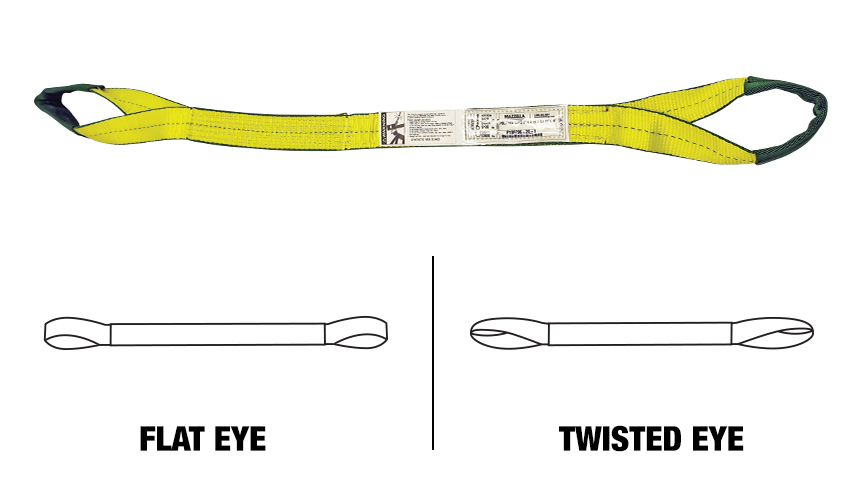
Eye and eye web slings have eyes sewn into both ends of the sling. Eye and eye slings can be configured with either a flat eye or twisted eye on both ends. A flat eye can be used in a choker hitch, basket hitch, or vertical hitch, while a twisted eye sling has eyes that are twisted 90° to form a better choker hitch.
Endless/Infinite Loop (EN) Web Slings
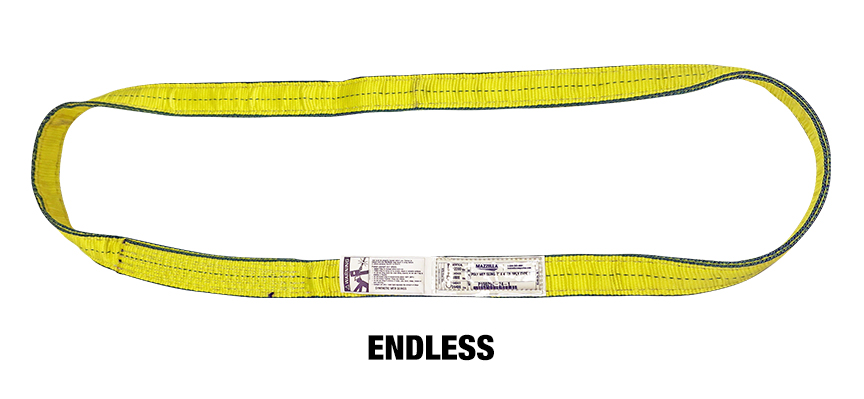
Endless web slings can be used in all three types of sling hitches. The sling can be rotated throughout its service life to minimize wear and avoid repetitive use damage.
Reversed Eye (RE) Web Slings
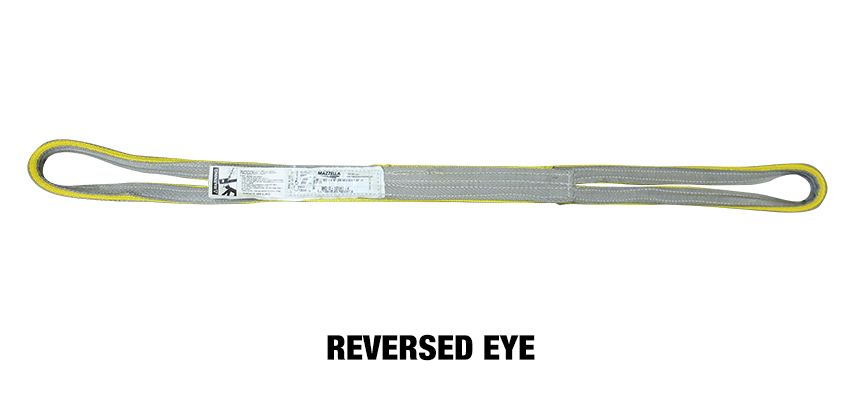
A reversed eye web sling is actually an endless sling with butted edges sewn together to double the sling width. Reversed eye slings typically have reinforced eyes and wear pads on both sides of the body for premium resistance to wear and abrasion.
Triangle / Choker Fittings (TC) Web Slings
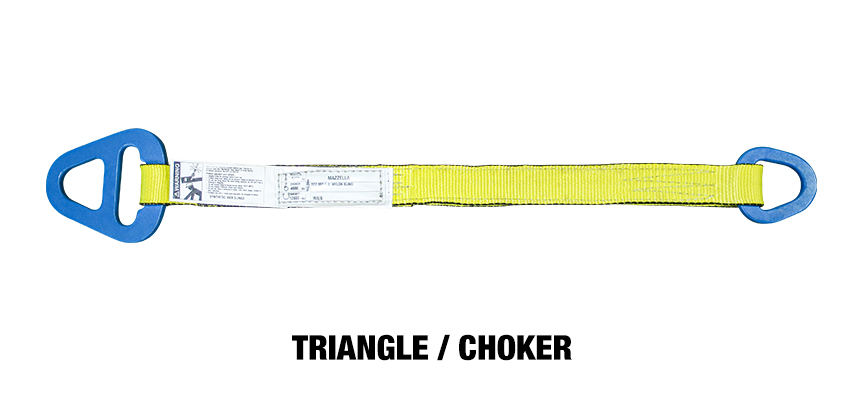
This type of sling is configured with a triangle and choker fitting on either end. These types of slings are typically used in a choker hitch and can be used in vertical and basket hitches as well.
Triangle / Triangle Fittings (TT) Web Slings
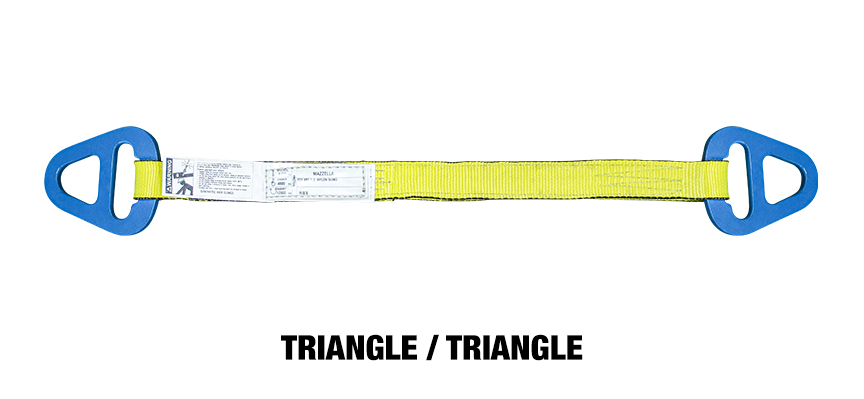
This type of sling is configured with a triangle fitting on each end. These types of slings are normally used in a basket hitch, but can also be used in a vertical hitch. They cannot be used as a choker.
Wide Lift (LT) Web Slings
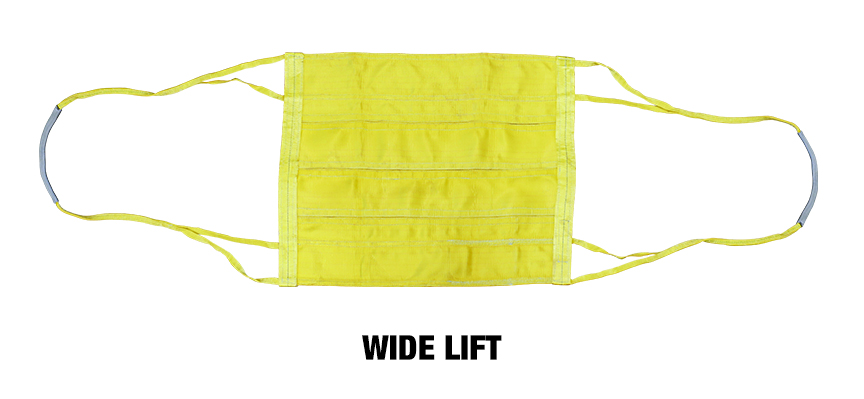
As the name suggests, wide lift slings have a wider width and more surface area than traditional web slings and are used in a basket hitch. This wider surface provides extra stability for bulky loads and added protection for fragile loads or finished surfaces.
***Traditionally, standard-length web sling eyes are going to be between 6” to 9”. As the sling length increases, so does the eye size. With our standard stock web slings, they come fitted with an extra Cordura® buffer in the bearing of the eye to add a little bit more production and longevity to the sling.
How Do You Accurately Measure a Web Sling?
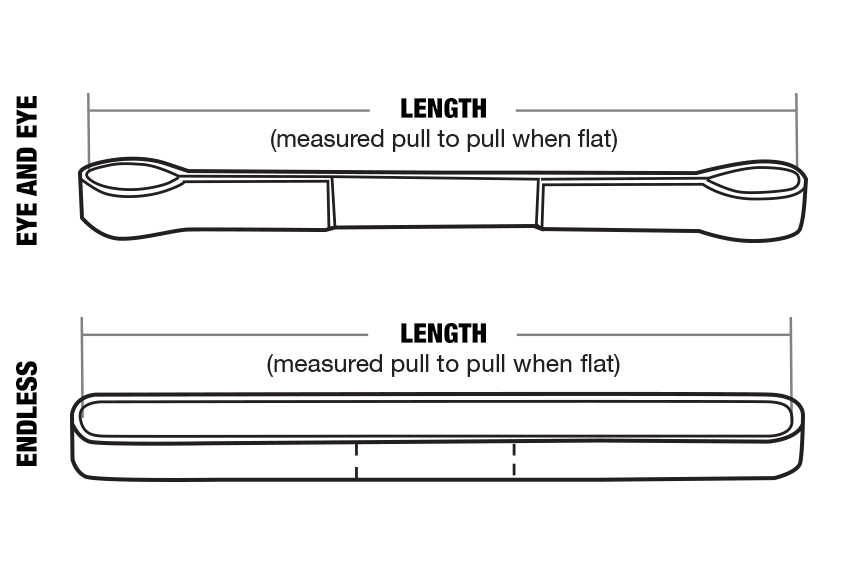
Synthetic web slings can come in virtually any length. Many manufacturers have standardized product offerings, including incremental increases in length ranging anywhere from 2’ to 20’. However, it’s also common for manufacturers to offer customized sling lengths, so you can get a web sling designed to your application’s exact specifications.
When determining sling length, measure from the top load-bearing point to the bottom load-bearing point. An eye and eye sling length is measured from tip to tip of the eyes. Multi-leg sling assemblies, or single-leg slings with fittings, are measured from the load-bearing point of any rings, hooks, or fittings.
Polyester vs. Nylon Lifting Slings
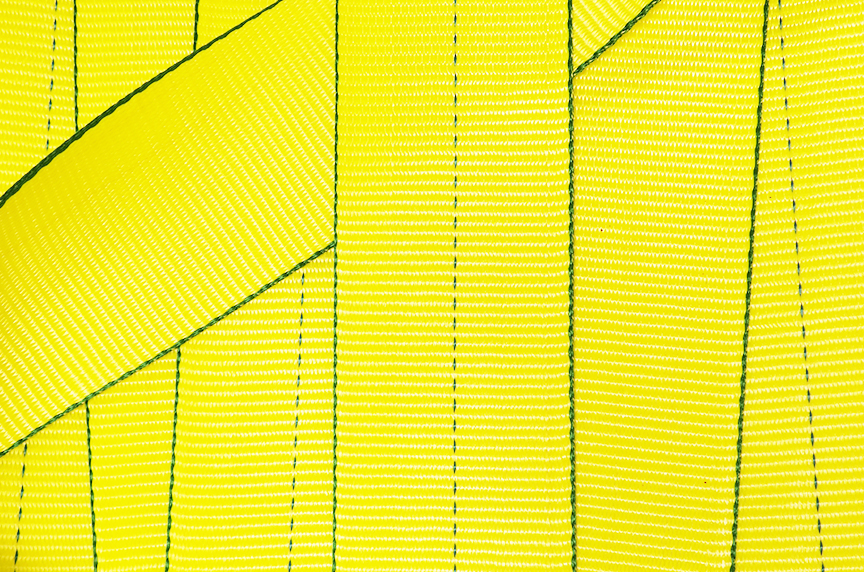
When choosing a material for synthetic sling use, we recommend considering a material’s resistance to specific chemicals, temperature resistance, and stretch. Below we’ll provide some of the considerations and characteristics of a polyester slings vs. a nylon sling to help you make more of an informed decision.
Synthetic Polyester Slings
- Approximately 3% stretch at rated capacity – less bounce allows for more load control during a lift
- Polyester is a softer material and less abrasive to sensitive or delicate finishes on loads
- Lower liquid absorption compared to nylon and is non-conductive
- Resistant to acidic environments and interactions with bleaching agents
- Good for low headroom lifts
- More popular in Europe but becoming more popular in the U.S. as the cost of nylon material continues to rise
- Not recommended for alkaline environments including aldehydes, ethers, and strong alkalis
- Can’t be used in environments in excess of 194°F or below -40°F
Synthetic Nylon Slings
- 8-10% stretch at rated capacity – can help reduce shock loading, but stretch must be accounted for in low headroom lifts
- Unaffected by grease and oil
- More popular in the United States and most widely used material for general purpose synthetic web slings
- Resistant to aldehydes, ethers, and strong alkalis
- Not recommended for acidic environments or for use with bleaching agents
- Retains moisture which can add to or cause stretch under load—however moisture does not affect capacity
- Will conduct electricity because they can absorb moisture / water—NEVER bet your life on this!
- Can’t be used in environments in excess of 194°F or below -40°F
See the chart below for guidelines on what type of slings can be used in conjunction with various types of chemicals:
| Chemicals | Nylon | Polyester |
|---|---|---|
| Acids | No | * |
| Alcohols | Yes | Yes |
| Aldehydes | Yes | No |
| Strong Alkalis | Yes | ** |
| Bleach Agents | No | Yes |
| Dry Cleaning Solvents | Yes | Yes |
| Ethers | Yes | No |
| Halogenated Hydrocarbons | Yes | Yes |
| Hydrocarbons | Yes | Yes |
| Ketones | Yes | Yes |
| Oils (Crude) | Yes | Yes |
| Oils (Lubricating) | Yes | Yes |
| Soaps & Detergents | Yes | Yes |
| Water & Sea Water | Yes | Yes |
| Weak Alkalis | Yes | Yes |
* Disintegrated by concentrated sulfuric acid
** Degraded by strong alkalis at elevated temperatures
What You Need To Know Before Ordering Web Slings
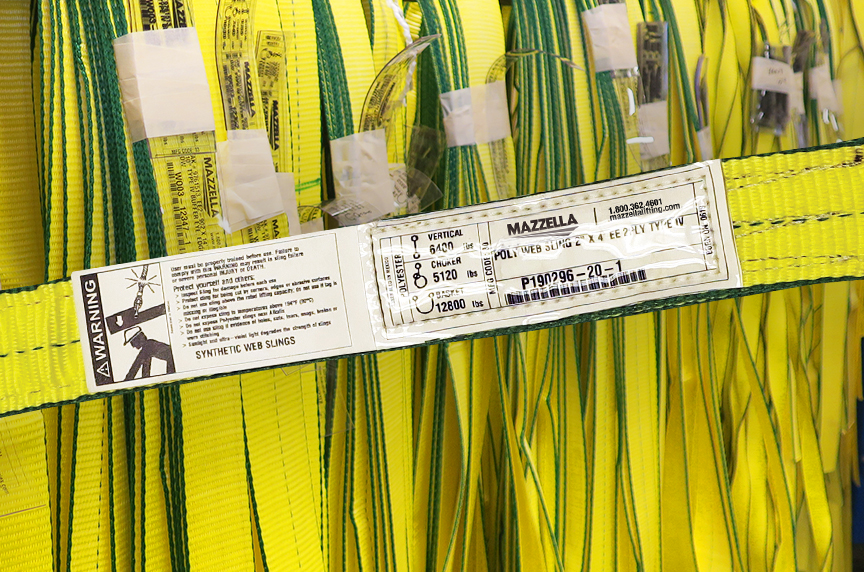
There are several questions you may need to answer before selecting web slings for your lifting application, including:
- What capacity do you need your slings to have?
- What sling width do you need?
- How many plies do you want on your web sling?
- What kind of eye do you want for your web sling?
- Are you going to use web slings around any edges?
- How many slings will be used to make your lifts?
- What type of hitch will you use for your lifting applications?
- Single leg (straight vertical eye & eye)
- Choker (put one eye through the other to wrap around a load)
- Basket (the sling goes underneath a load and both eyes go vertical)
How Many Plies of Material Are Required to Execute a Safe Lift?
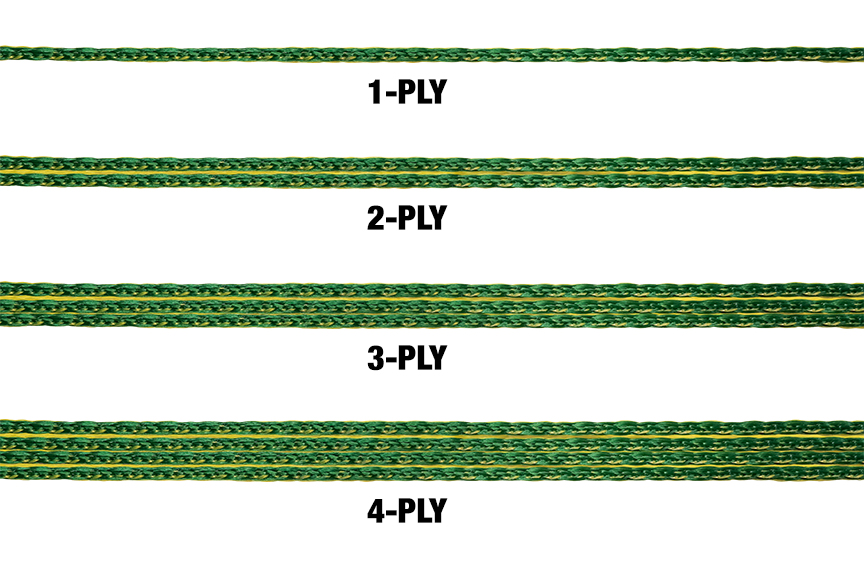
The ply number, or number of plies, refers to the layers of webbing that make up the body of the sling. A web sling is generally available in 1, 2, 3, or 4-ply configurations. Adding more plies to the sling provides added strength to the body of the sling.
Lifting capacity is going to determine how many plies are needed to execute your lifts safely. More times than not, when you have higher-capacity lifts, you’re going to have more plies on your web slings.
For example, if the breaking strength of a 1-ply web sling = X, then…
The breaking strength of an equivalent 2-ply web sling = 2X
The breaking strength of an equivalent 3-ply web sling = 3X
The breaking strength of an equivalent 4-ply web sling = 4X
Web Sling Width
With a wider sling body, the load is distributed over a larger sling surface area. Wider width slings provide greater protection to delicate or finished surfaces, as well as better load balance and control for large or heavy loads. Typical standard sling lengths can range anywhere from 1” to 12” in width. Larger sizes are available as special-orders, or in a special wide lift sling configuration.
If you don’t want to use a three-ply web sling, you may want to increase the width of your synthetic material for better load control.
A lot of times, if you’re using your sling in a basket hitch configuration, that additional width is going to help keep a load balanced more than using a thinner sling. With a thinner sling, the load might move if you’re just using one. Determining what you need to execute your lifts is key to finding the right rigging gear.
How Do You Determine If You Need an Eye & Eye Sling or Endless Web Sling?
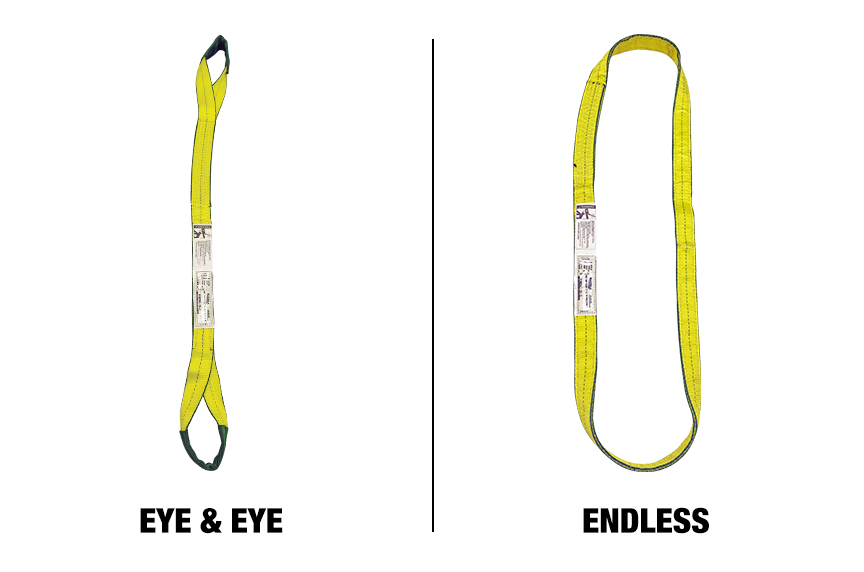
Typically, it comes down to personal preference. You can do every type of hitch with an endless sling that you can do with an eye & eye sling. The flat web slings might end up being a little bit more costly depending on the plies because the length could be doubled or tripled. Sometimes, with an eye & eye web sling, you’ll use less material, which can be a better price point for the customer.
If you’re going to use an endless web sling, roundslings could be a less expensive option for you.
How Can You Protect Your Web Slings?
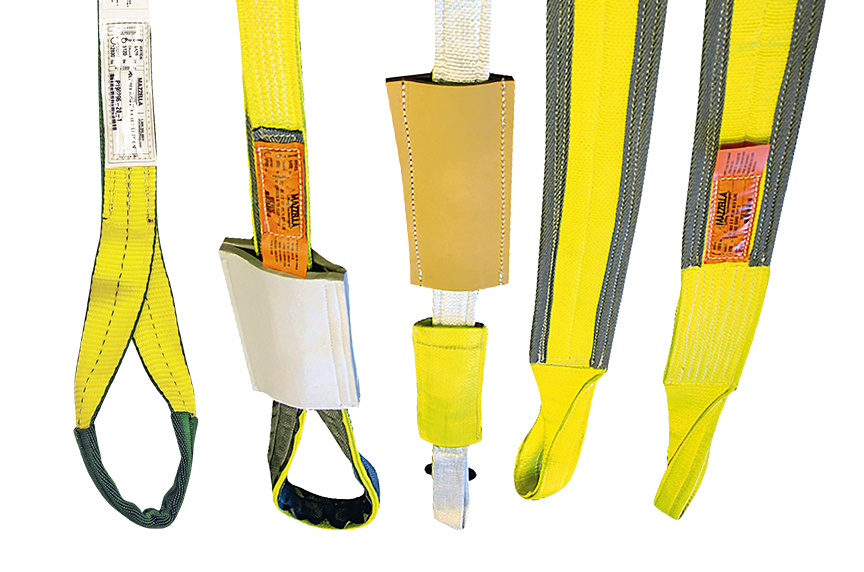
There are several different ways that you can incorporate added wear, cut, and abrasion protection to a synthetic web sling. When you know how to properly maintain and care for your slings, you can help extend the service life of the product and get a better return on your investment.
These are some of the web sling protection options that can be added during the manufacturing process, or purchased as an add-on:
- Sling wear pads can be sewn into the webbing material at specific wear points along the sling body or in the eyes
- Edge guards can be sewn along the edges of the sling to offer added protection at critical spots that are prone to abrasion, wear, or cutting
- A sleeve or tube slides over the body of the sling and protects both sides of the sling body while in use
- A wrap, similar to a sleeve, is sewn onto the body of the sling to protect the edges and lifting of the surface from wear or cutting
- A special coating can be added to the webbing material during the manufacturing process. This protects against moisture and dirt penetration, and also, helps reduce abrasion
- Special types of shackles are designed specifically for use with web slings. A wider sling bearing surface results in an increased area for load distribution and allows for 100% working load limit (WLL) efficiency.
Always make sure that you follow ASME B30.9 Slings guidelines when inspecting your web slings. Regular inspection of your slings—especially before each use—is crucial to help identify any damage or irregularities that may compromise the strength and integrity of the sling. Web slings are especially susceptible to damage from edges, rough surfaces, heat, chemical exposure, and UV light degradation!
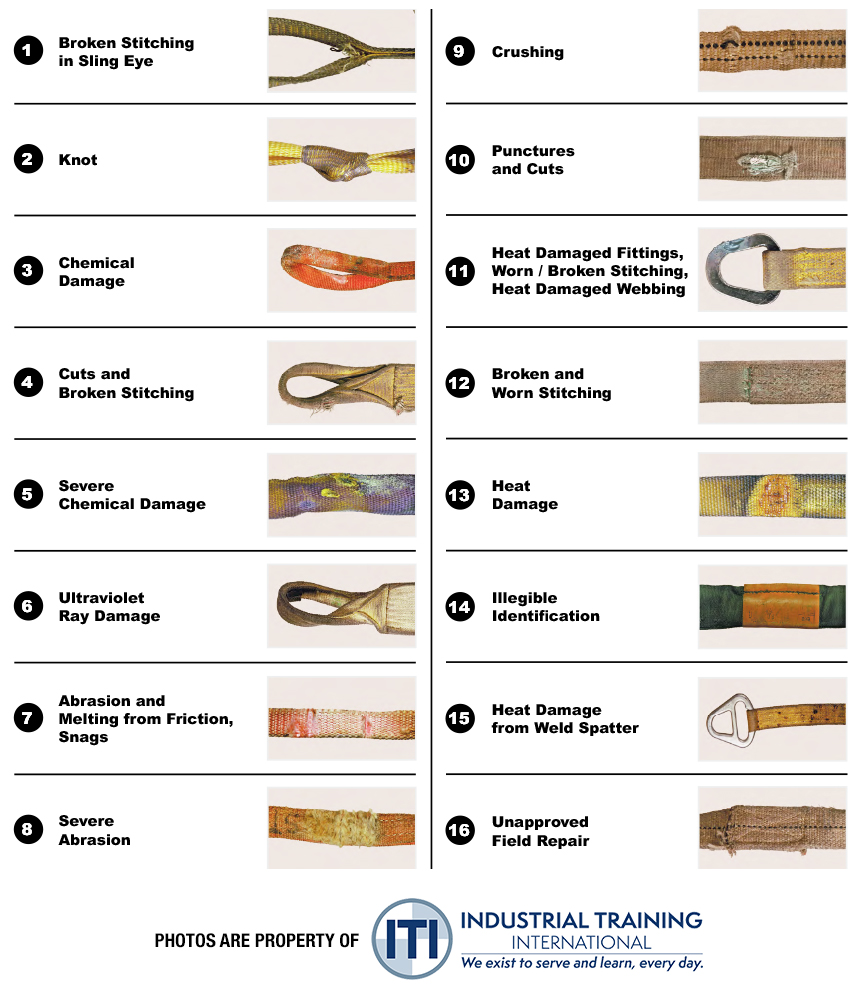
What Environments Work and Don’t Work for Web Slings?
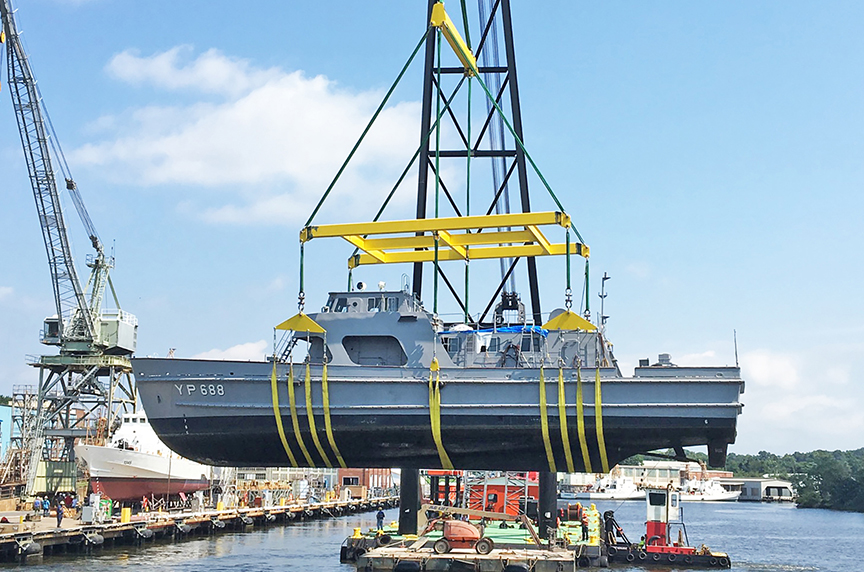
Good-Fit Applications
Good-fit applications for synthetic web slings include:
- Manufacturing shops
- Outdoor environments
- Cleaner environments without flying debris
Bad-Fit Applications
While synthetic web slings are favorable in price, they’re very prone to damage. Once you get a cut or a tear in the webbing, you can’t really repair it.
Any environment in which the web sling will be subject to cut or melt potential is a bad fit. Excess heat cause the fibers to start melting, which will lead to sling failure. Also, in applications with sharp edges, web slings will not be a good fit.
Even if an edge is rounded enough for you to run your finger across it without damage, once you put a web sling around that edge, it could end up getting cut. With any kind of edge application, you want to use an edge protector.
You can use web slings outdoors, but once they get exposed to UV (ultraviolet) rays, it’s going to degrade the sling very quickly, and you may not get as many uses. If you’re using web slings in the weather, remember it’s not good to submerge them in water for prolonged periods of time. If the slings see a little bit of rain, you’ll be able to continue using them.
Are Web Slings the Answer For You?
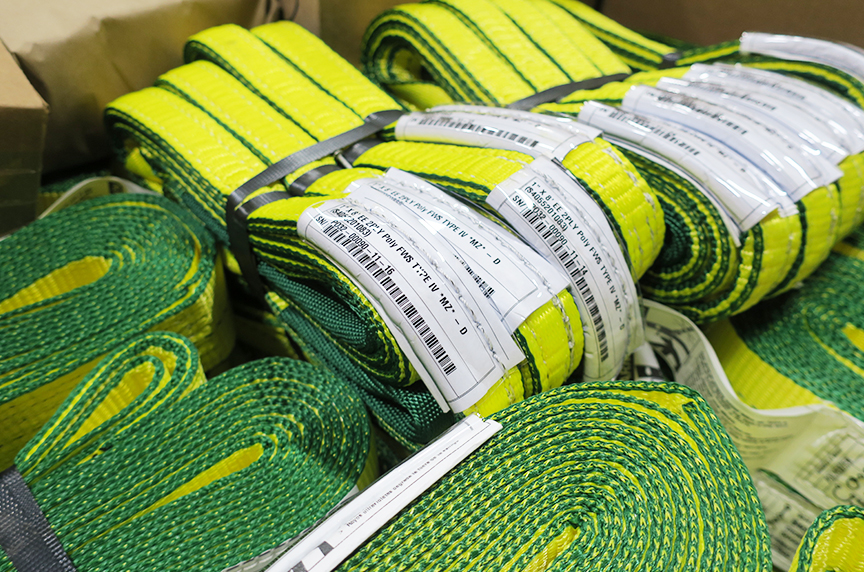
If you want to switch from heavy wire rope or chain to a comparable-capacity web sling, or you’re replacing a sling that’s been damaged or failed inspection, here’s what you’ll need to know to order the correct style sling for your lifting application:
- Working Load Limit
- Sling webbing material
- Number of legs (single or multi-leg assemblies)
- Sling configuration (eye style, endless, or fittings on each end)
- Sling length
- Number of plies
- Sling width
- Additional cut, wear, or abrasion resistance
However, if after reviewing this piece, you believe web slings are no longer a good fit for your lifting needs, Mazzella offers resources in The Learning Center to help you learn about different types of slings, including:
- Roundslings
- Wire rope slings
- Slingmax® Twin-Path® slings
At Mazzella, we provide ideal lifting solutions—offering all styles of lifting slings, rigging hardware, wire rope, overhead cranes and hoists, and engineered lifting devices. We have more than 30 locations across the United States—fully stocked with different sizes and configurations of rigging products for your next project.
Make sure to download our Lifting Slings Types & Terms E-book for more info.

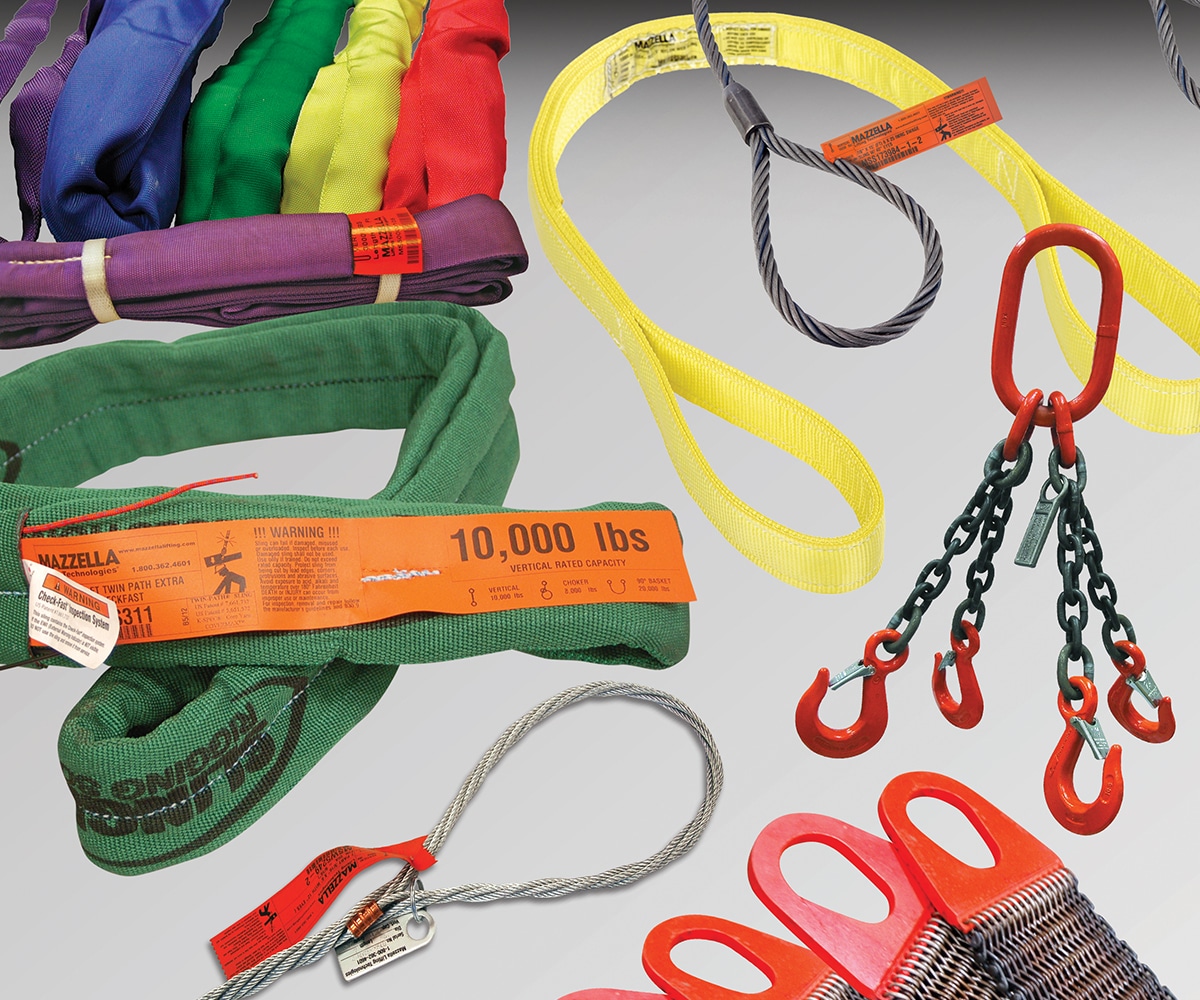
Slings & Assemblies
Are you looking for lifting slings, including chain, wire rope, synthetic flat web, metal mesh, cordage, and single-path / high-performance roundslings? We can help provide the right sling for your needs!
Additionally, if you need sling assemblies—both large and small, we can manufacture bridge cables, crane cables, steel mill cables, and thousands of OEM assemblies.
Contact us today to get the lifting slings and assemblies you need!
Learn more about lifting slings and assemblies!
Copyright 2021. Mazzella Companies.

